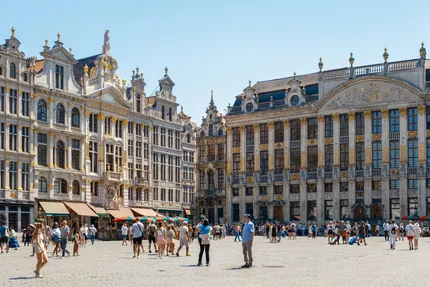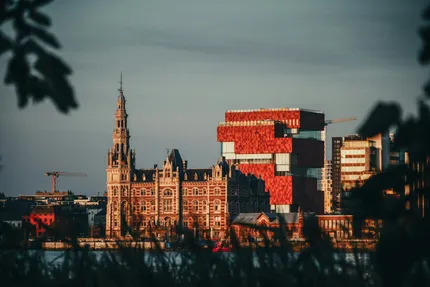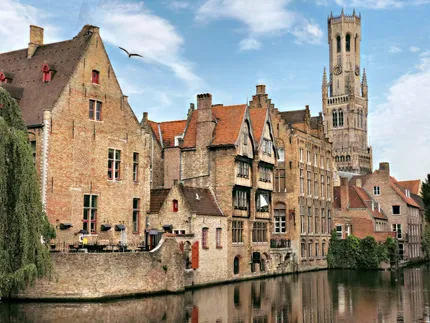CityTouring
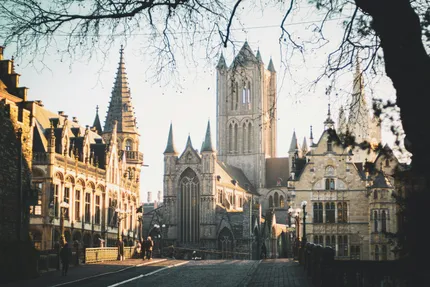
City trip to Ghent
BelgiumCanal-laced Ghent blends a remarkably preserved medieval core with the energy of a large university city, making it an easy, interesting city-break base in Flanders. In the compact center, Graslei and Korenlei’s guild houses line the Leie River, best appreciated from a boat tour or the quay. Nearby, the 12th‑century Gravensteen castle, Saint Bavo’s Cathedral with Van Eyck’s restored Adoration of the Mystic Lamb, Saint Nicholas’ Church, and the UNESCO‑listed Belfry cluster within minutes’ walk. Beyond monuments, Ghent excels at everyday livability: tram-linked neighborhoods, bike lanes, and a largely car-light core encourage exploring cafés, independent shops, and street art (including the ever-changing Graffiti Street).
The museum offer ranges from the MSK’s Old Masters to contemporary S.M.A.K. and the STAM city museum. Industrial sites have been reimagined into creative districts and waterside hangouts, while De Krook’s striking library anchors the modern skyline. Dining spans classic Flemish dishes like waterzooi and stoofvlees to an unusually strong plant-based scene—Ghent pioneered "Thursday Veggie Day." Local beers and the conical cuberdon sweet finish the taste of the city.
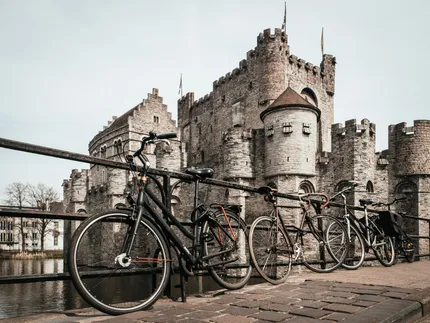
Gravensteen (Castle of the Counts)
Gravensteen (Castle of the Counts) is a 12th-century fortress dominating Ghent's center. Walk the ramparts, keep, and restored halls to grasp medieval power in Flanders. Displays address arms, justice, and daily life. The rooftop walkway delivers sweeping city views. Clear audio guides add context and humor, keeping visits focused and engaging.
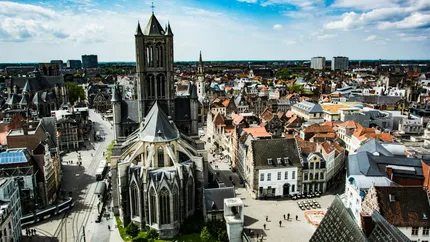
Saint Bavo's Cathedral and the Ghent Altarpiece
Saint Bavo's Cathedral houses Van Eyck's Ghent Altarpiece, a landmark of Northern Renaissance art. See the restored panels up close with timed entry. The cathedral's soaring nave, baroque furnishings, crypt, and Rubens' Saint Bavo painting reward a careful look. Multilingual media guides help decode symbolism. Combine with nearby Belfry for contrasting civic power.
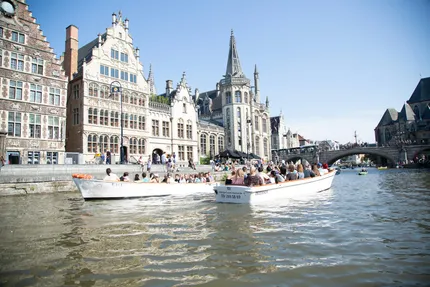
Canal Boat Tour on the Leie and Lieve
A canal boat tour offers an efficient overview of central Ghent. Guided trips along the Leie and Lieve reveal facades, bridges, and Gravensteen from the water. Boats are covered or open, with multilingual commentary. Tours run frequently; no need to prebook outside peak events. Combine with walking to target areas you liked.
Ghent suits culture-first weekenders who want dense, walkable sightseeing without tour-bus fatigue. History and architecture enthusiasts get a tight cluster of highlights—Gravensteen, the Belfry, Saint Bavo’s, and canal-front guild houses—plus well-presented context at STAM. Art lovers can pair Old Masters at MSK with cutting-edge shows at S.M.A.K., and see the meticulously restored Van Eyck altarpiece in situ. Food-focused travelers, especially vegetarians and vegans, will appreciate the city’s many plant-forward eateries alongside staples like waterzooi, Flemish stew with fries, and sharp Tierenteyn mustard; local beer bars and small breweries round out evenings. Photographers benefit from Ghent’s renowned lighting plan, which bathes monuments and bridges after dark, and from boat tours for low-angle canal views. Active travelers can rely on cycling infrastructure and flat terrain to explore neighborhoods and green spaces such as Citadelpark, or follow the Leie south toward art villages on a longer ride.
Families find manageable distances, a dramatic castle to explore, interactive museums, and plenty of casual dining. Budget-conscious visitors—thanks to the student population—will find affordable lunches, bars with generous happy hours, and good-value passes like the CityCard Gent. Night owls can sample live music and club nights around Vooruit and cozy brown cafés near Patershol and the Vrijdagmarkt. With frequent trains to Ghent‑Sint‑Pieters, abundant trams, and a largely car-free center, the city rewards short stays of two to three days focused on art, history, food, and relaxed urban exploring.
Three top reasons for a city trip to Ghent
- Explore Ghent’s medieval heart: climb the UNESCO-listed Belfry, tour the formidable Gravensteen Castle, admire Van Eyck’s Adoration of the Mystic Lamb in St. Bavo’s Cathedral, and stroll Graslei-Korenlei’s picturesque canals.
- Immerse in Ghent’s creative energy: experience Gentse Feesten festival, explore SMAK and STAM museums, discover ROA’s murals, dine in Patershol on waterzooi and stoverij, and sip beers at Dulle Griet.
- Savor Ghent’s atmosphere: glide by boat along the Leie and Scheldt, wander the Lichtplan night walk illuminating monuments, and enjoy cyclist-friendly, car-free streets brimming with cafés, student buzz, and terraces.
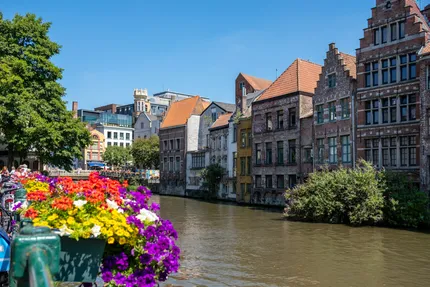
Best time to visit Ghent
Late spring and early autumn are the sweet spot for Ghent. May–June and September offer mild temperatures, long daylight, and comfortable crowds, ideal for walking, cycling, and canal cruises. July brings the 10‑day Gentse Feesten, one of Europe’s largest city festivals: brilliant atmosphere and free outdoor stages, but expect packed streets and higher prices; book well ahead. August is quieter after the festivities. Winter is cold and short on daylight, yet cozy, with attractive evening lighting and a Christmas market in December; some attractions run reduced hours. Weather is changeable year‑round, so bring layers and a light rain jacket.
More activities and things to see in Ghent:
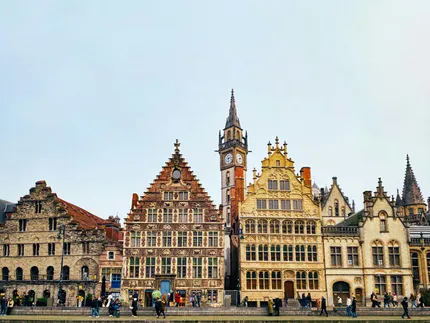
Graslei and Korenlei
Graslei and Korenlei are photogenic medieval quays lining the Leie. Historic guild houses, reflections, and cafe terraces make a relaxed base between sights. It's prime at sunset and during light festivals. From Saint Michael's Bridge, capture Ghent's three towers. Boat tours depart nearby, and street life offers reliable people-watching without detours.
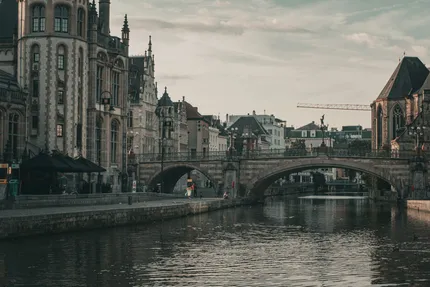
Saint Michael's Bridge Panorama
Saint Michael's Bridge provides the classic panorama of Ghent: the Graslei and Korenlei quays below, and the aligned trio of Saint Nicholas' Church, the Belfry, and Saint Bavo's Cathedral ahead. It's easy to fit into any route and best at blue hour. Expect crowds; step aside for cyclists and photographers.
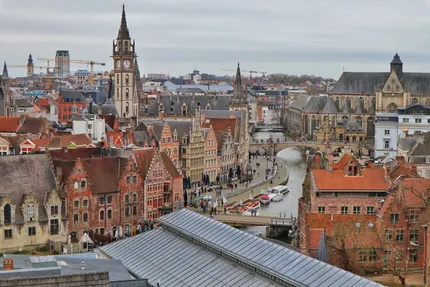
Patershol Historic Quarter
Patershol is a compact medieval quarter of cobbled lanes, low houses, and small squares. It's ideal for an evening stroll and dinner, with kitchens ranging from Flemish classics to international. Look for hidden passages and courtyard glimpses. The area's scale, intact street plan, and limited traffic create atmosphere without requiring long detours.
Belfry of Ghent and Cloth Hall
The Belfry of Ghent, with its dragon weather vane, symbolizes civic independence. Climb or use the lift to reach panoramic views over roofs, spires, and waterways. The attached Cloth Hall recalls medieval trade. Listen for carillon concerts. Exhibits explain watchmen's duties, alarm bells, and guild power in a compact, well-signed space.
STAM - Ghent City Museum
STAM - Ghent City Museum explains how the city grew from a medieval port to a modern university and cultural center. Galleries mix artifacts, models, and multimedia, including a giant aerial map you can walk on. Housed in a former abbey with a contemporary wing, it's a clear orientation stop early in your visit.
MSK - Museum of Fine Arts Ghent
MSK - Museum of Fine Arts Ghent presents Flemish Primitives, Baroque masters, and strong nineteenth-century Belgian painting in a sober neoclassical building at Citadelpark. Highlights include works by Bosch's circle, Pieter Brueghel the Younger, Rubens, Ensor, and others. Labels are concise. Temporary exhibitions broaden context. Combine with nearby SMAK for contemporary contrasts.
SMAK - Municipal Museum of Contemporary Art
SMAK - Municipal Museum of Contemporary Art sits opposite MSK in Citadelpark. Rotating shows feature Belgian and international artists across media, from painting and video to installations. The collection includes Broodthaers, Panamarenko, and more. Exhibitions are well-produced without being overwhelming. Check schedules, as content changes often, rewarding repeat visits or targeted stops.
St Peter's Abbey and Gardens (Sint-Pietersabdij)
St Peter's Abbey (Sint-Pietersabdij) combines atmospheric cloisters, archaeological remains, and peaceful gardens with seasonal exhibitions. The terraced herb garden and vineyard feel secluded despite being central. Interpretive panels and models clarify the abbey's role in Ghent's early development. It's a good pause between downtown sights and Citadelpark, with plenty of benches and shade.
Vrijdagmarkt Square and Dulle Griet Cannon
Vrijdagmarkt is a broad medieval square framed by guild buildings and cafes, still hosting markets. It's a practical stop for a drink between sights. Nearby stands the massive 16th-century Dulle Griet cannon on Grootkanonplein. The area's scale, statues, and signage offer quick historical context without requiring a full guided tour.
Getting around in Ghent
Ghent’s compact historic core is largely car-free, so most central sights are easiest to reach on foot. For longer hops, public transport run by De Lijn is reliable: tram lines 1, 2 and 4 link Gent-Sint-Pieters station with the city center, the arts district, and the northern neighborhoods, and a dense bus network fills the gaps. Buy tickets via the De Lijn app or at station machines; validators are on board. Cycling is one of the fastest ways to move around: the city has extensive bike lanes, traffic-calmed streets, and abundant parking. Short-term rentals are widely available, including Blue-bike at Gent-Sint-Pieters and Dampoort stations and dockless options like Donkey Republic. Driving in the center is discouraged by circulation plans, low-emission rules, and limited parking; use P+R lots on the ring and continue by tram or bus. Taxis and rideshare are useful late at night when frequencies drop. Visitor boat tours operate on the rivers but are scenic rather than practical for daily travel.
Getting to Ghent
By air, Brussels Airport (BRU) is the most convenient gateway for Ghent, with frequent trains from the airport station to Gent-Sint-Pieters, usually direct or with a simple change in Brussels; the journey takes about 45–60 minutes. Brussels South Charleroi (CRL) serves many low-cost carriers; reach Ghent by coach to Brussels Midi and onward IC train, or occasional direct shuttle services. Smaller airports at Antwerp and Ostend-Bruges have limited networks. By train, Gent-Sint-Pieters is the main hub with fast intercity links: Brussels Midi in about 30 minutes, Bruges 25–30, Antwerp roughly an hour, and Lille via Kortrijk in around 90 minutes. Internationally, connect in Brussels to Eurostar for London and Paris, to high-speed services toward Amsterdam and Cologne/Frankfurt, and to TGV or ICE for wider European destinations. Long-distance coaches (primarily FlixBus) serve Ghent, typically stopping near Dampoort or Sint-Pieters, with routes to Paris, Amsterdam, Lille, London and German cities. If arriving by car, expect congestion on the R40/R4 ring roads and consider Park-and-Ride facilities.
